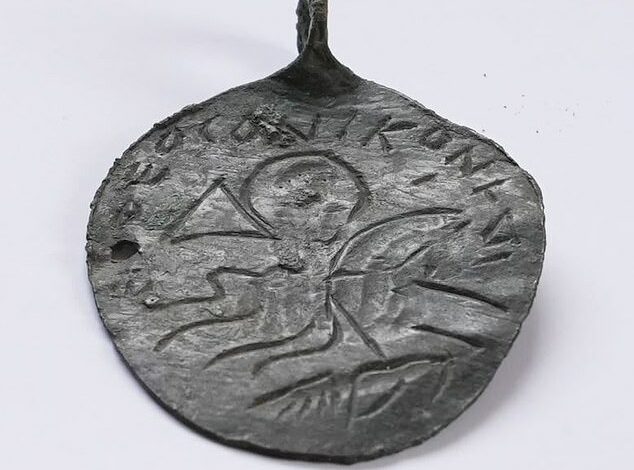An ancient amulet depicting a biblical demon slayer confirms the missing text from the Holy Book

A rare fifth-century amulet depicting a Biblical demon slayer may confirm a missing text that claimed King Solomon had power over evil.
The 1,600-year-old bronze pendant, found in Turkey, contained images of Solomon defeating the devil with the ancient Greek inscription: ‘Our Lord defeated the devil.’
Solomon, the son of King David, was the focus of a chapter written between the 1st and 5th centuries AD, but it was not included in the canonical Bible due to its emphasis on magic and demonology.
The book, entitled ‘Testament of Solomon’, begins with the Archangel Michael giving Solomon a magical ring to summon, interrogate and control demons.
Now archaeologists working in the ancient city of Hadrianopolis have discovered the amulet among the ruins of a military structure, suggesting a soldier wore it knowing Solomon could drive away the forces of evil.
There were also names of four holy angels, Azrail, Gabriel, Michael and Israfil, on the back of the amulet, supporting the idea that the amulet was used as a symbol of protection.

The 1,600-year-old amulet depicts King Solomon on horseback with a spear in his hands defeating the devil
Solomon appears in three books of the Bible, with 1 Kings 3:12 stating that God gave him “a wise and discerning heart, so that there never has been, nor ever will be, anyone like you.”
The Bible also describes how he generated extreme wealth during his reign, amassing at least 25 tons of gold annually.
In 2 Chronicles 1:11, Scripture describes, “But since you have asked for wisdom and knowledge to rule my people, over whom I have made you king, I will give you wisdom and knowledge.
“I will also give you more wealth, wealth and honor than any king who lived before you or who will live after you.”
But the Testament of Solomon tells a different side of the wealthy king, one who fought demons – and the amulet suggested that ancient people believed the stories to be true.
Associate professor Dr. Ersin Çelikbaş, Department of Archaeology, Faculty of Arts, Karabük University, said: ‘Similar examples have not been found in this geography before.
‘This pendant, used as an amulet, attracts attention because of the inscriptions on both sides and the image on it.
‘The amulet depicts the Prophet Solomon on a horse, with a spear in his hand, defeating the devil.

Archaeologists working in the ancient city of Hadrianopolis discovered the amulet among the ruins of a military structure, indicating that a soldier wore it knowing that Solomon could overthrow the forces of evil

Solomon, the son of King David, was the focus of a chapter written between the 1st and 5th centuries AD, but it was not included in the canonical Bible due to its emphasis on magic and demonology.

The discovery was made during excavations of a fortified structure in the ancient city of Hadrianopolis in Paphlagonia, near modern-day Eskipazar, Karabük province.
‘Prophet Solomon is an important figure in all three holy religions. Although he is mentioned as a ruler in the Torah and the Bible, he is also accepted as a prophet in Islam.’
King Solomon is known as Hz. Suleyman in Islam, who was also known as the commander of the armies.
“We understand that he was also seen as a protective figure for the cavalrymen of the Roman and Byzantine periods in Hadrianopolis,” Dr Çelikbaş said.
The angels mentioned on the back of the pendant are also part of different religions.
Azrail is the angel of death in Islam and is responsible for transporting the souls of the deceased to the afterlife.
And Israfil, also known in religion, was an archangel who blew a trumpet to announce the Day of Resurrection.
Gabriel and Michael are well known in the Christian faith, with the former being a messenger for God and the latter known as a spiritual warrior in the battle of good versus evil.

The pendant was probably worn by a soldier as a symbol of protection

An iron face mask (pictured) believed to have been worn by an experienced member of the Roman cavalry some 1,800 years ago has been unearthed in north-central Turkey. The team found this relic in 2021
Dr. However, Çelikbaş explained that he and his team believed the pendant was a Christian artifact.
The ancient city of Hadrianopolis was first known as Uskudama by the tribes called Thracians who inhabited the region from the 1st century BC to the 8th century AD.
However, the city was later rebuilt around 124 AD by the Roman Emperor Hadrian and is today called Edirne.
Dr. Çelikbaş and his team have been working at the site since 2003 and have found ancient Roman relics and structures, including two baths, two churches, a theater, rock tombs, a monumental niche, a villa and a square, fortified building.
In 2021, they discovered an iron face mask in the building that would have been worn by an experienced member of the Roman cavalry some 1,800 years ago.
‘Rome intended to make its defense on the other side [of its empire] by building bases against all kinds of dangers that could come to its territory from the Black Sea region,” explained Dr. Çelikbaş out.
‘We think Hadrianopolis is one of these defensive military cities.
‘The [mask] belongs to the imperial period. It is very likely – if we look at similar examples [the stratigraphic location of the find] — from the 3rd century AD.’




